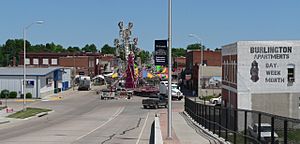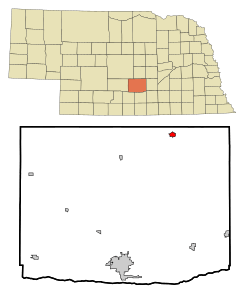Ravenna, Nebraska facts for kids
Quick facts for kids
Ravenna, Nebraska
|
|
|---|---|

Downtown Ravenna during Annevar festival
|
|

Location of Ravenna, Nebraska
|
|
| Country | United States |
| State | Nebraska |
| County | Buffalo |
| Area | |
| • Total | 1.67 sq mi (4.31 km2) |
| • Land | 1.66 sq mi (4.30 km2) |
| • Water | 0.01 sq mi (0.01 km2) |
| Elevation | 2,015 ft (614 m) |
| Population
(2020)
|
|
| • Total | 1,441 |
| • Density | 867.55/sq mi (335.05/km2) |
| Time zone | UTC-6 (Central (CST)) |
| • Summer (DST) | UTC-5 (CDT) |
| ZIP code |
68869
|
| Area code(s) | 308 |
| FIPS code | 31-40710 |
| GNIS feature ID | 838204 |
| Website | http://www.myravenna.com/ |
Ravenna is a small city in Buffalo County, Nebraska, in the United States. It is part of the larger Kearney area. In 2020, about 1,441 people lived there.
Contents
History of Ravenna
Ravenna was started in 1886. This happened when the Burlington Railroad built its tracks through the area.
The city was named after the famous city of Ravenna, Italy. You can still see this connection today, as many streets in Ravenna, Nebraska, have names that come from other places in Italy. The city officially became a town in October 1886.
Geography and Climate
Ravenna is located in central Nebraska. The city covers a total area of about 1.67 square miles (4.31 square kilometers). Most of this area is land, with a very small amount of water.
Weather in Ravenna
Ravenna has a climate with warm summers and cold winters. Here's a quick look at the weather:
| Climate data for Ravenna, Nebraska (1991–2020 normals, extremes 1893–present) | |||||||||||||
|---|---|---|---|---|---|---|---|---|---|---|---|---|---|
| Month | Jan | Feb | Mar | Apr | May | Jun | Jul | Aug | Sep | Oct | Nov | Dec | Year |
| Record high °F (°C) | 78 (26) |
80 (27) |
92 (33) |
98 (37) |
103 (39) |
109 (43) |
116 (47) |
111 (44) |
105 (41) |
99 (37) |
86 (30) |
82 (28) |
116 (47) |
| Mean maximum °F (°C) | 61.7 (16.5) |
65.8 (18.8) |
78.0 (25.6) |
85.3 (29.6) |
90.7 (32.6) |
95.1 (35.1) |
97.8 (36.6) |
95.2 (35.1) |
91.8 (33.2) |
86.5 (30.3) |
74.2 (23.4) |
62.1 (16.7) |
99.0 (37.2) |
| Mean daily maximum °F (°C) | 37.0 (2.8) |
40.6 (4.8) |
52.7 (11.5) |
62.8 (17.1) |
72.6 (22.6) |
82.8 (28.2) |
87.0 (30.6) |
84.9 (29.4) |
78.3 (25.7) |
65.7 (18.7) |
51.3 (10.7) |
39.2 (4.0) |
62.9 (17.2) |
| Daily mean °F (°C) | 24.4 (−4.2) |
27.6 (−2.4) |
38.3 (3.5) |
48.4 (9.1) |
59.6 (15.3) |
70.3 (21.3) |
74.9 (23.8) |
72.5 (22.5) |
64.3 (17.9) |
50.9 (10.5) |
37.4 (3.0) |
26.8 (−2.9) |
49.6 (9.8) |
| Mean daily minimum °F (°C) | 11.9 (−11.2) |
14.6 (−9.7) |
23.9 (−4.5) |
34.0 (1.1) |
46.6 (8.1) |
57.7 (14.3) |
62.9 (17.2) |
60.1 (15.6) |
50.2 (10.1) |
36.1 (2.3) |
23.4 (−4.8) |
14.3 (−9.8) |
36.3 (2.4) |
| Mean minimum °F (°C) | −9.1 (−22.8) |
−5.0 (−20.6) |
6.2 (−14.3) |
19.1 (−7.2) |
31.2 (−0.4) |
43.9 (6.6) |
52.1 (11.2) |
49.1 (9.5) |
34.1 (1.2) |
19.6 (−6.9) |
6.3 (−14.3) |
−4.5 (−20.3) |
−14.1 (−25.6) |
| Record low °F (°C) | −31 (−35) |
−37 (−38) |
−22 (−30) |
−2 (−19) |
18 (−8) |
32 (0) |
37 (3) |
36 (2) |
20 (−7) |
4 (−16) |
−15 (−26) |
−31 (−35) |
−37 (−38) |
| Average precipitation inches (mm) | 0.52 (13) |
0.64 (16) |
1.39 (35) |
2.70 (69) |
3.94 (100) |
4.41 (112) |
3.77 (96) |
3.34 (85) |
2.06 (52) |
2.10 (53) |
0.96 (24) |
0.67 (17) |
26.50 (673) |
| Average snowfall inches (cm) | 4.4 (11) |
7.0 (18) |
3.1 (7.9) |
1.7 (4.3) |
0.1 (0.25) |
0.0 (0.0) |
0.0 (0.0) |
0.0 (0.0) |
0.0 (0.0) |
0.8 (2.0) |
3.3 (8.4) |
4.0 (10) |
24.4 (62) |
| Average precipitation days (≥ 0.01 in) | 3.1 | 3.8 | 4.9 | 7.3 | 10.1 | 9.1 | 7.3 | 6.9 | 5.4 | 5.3 | 3.7 | 3.1 | 70.0 |
| Average snowy days (≥ 0.1 in) | 2.2 | 2.5 | 1.2 | 0.9 | 0.1 | 0.0 | 0.0 | 0.0 | 0.0 | 0.4 | 1.4 | 2.2 | 10.9 |
| Source: NOAA | |||||||||||||
Population of Ravenna
The number of people living in Ravenna has changed over the years. Here's how the population has grown and shrunk since 1890:
| Historical population | |||
|---|---|---|---|
| Census | Pop. | %± | |
| 1890 | 628 | — | |
| 1900 | 808 | 28.7% | |
| 1910 | 1,359 | 68.2% | |
| 1920 | 1,703 | 25.3% | |
| 1930 | 1,559 | −8.5% | |
| 1940 | 1,429 | −8.3% | |
| 1950 | 1,451 | 1.5% | |
| 1960 | 1,417 | −2.3% | |
| 1970 | 1,356 | −4.3% | |
| 1980 | 1,296 | −4.4% | |
| 1990 | 1,317 | 1.6% | |
| 2000 | 1,341 | 1.8% | |
| 2010 | 1,360 | 1.4% | |
| 2020 | 1,441 | 6.0% | |
| U.S. Decennial Census | |||
2010 Census Information
In 2010, there were 1,360 people living in Ravenna. These people made up 575 households and 338 families. The city had about 819 people per square mile.
Most of the people in Ravenna were White (98.2%). A small number were Native American, Asian, or from two or more races. About 2.0% of the population was Hispanic or Latino.
About 29.6% of households had children under 18. Many households (48.0%) were married couples. The average age in Ravenna was 40.9 years. About 25.9% of residents were under 18 years old.
Culture and Events
Ravenna has a special yearly event called Annevar. This name is "Ravenna" spelled backward! During Annevar, the city hosts fun activities. These often include a demolition derby and a tractor pull.
In 2017, Ravenna became a popular spot for a special event. About 8,000 visitors came to the town to see the solar eclipse of August 21, 2017. People traveled from all over the United States and even from other countries like Europe, Japan, and Australia to witness this amazing natural event in Ravenna.
See also
 In Spanish: Ravenna (Nebraska) para niños
In Spanish: Ravenna (Nebraska) para niños

